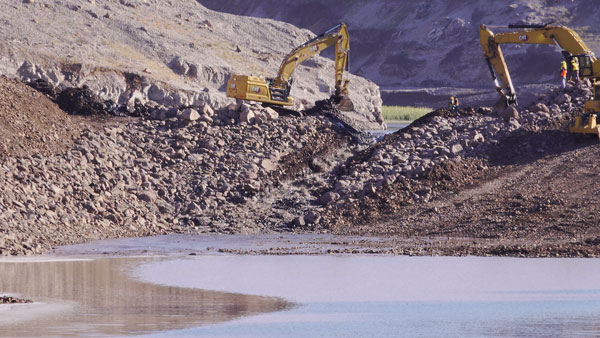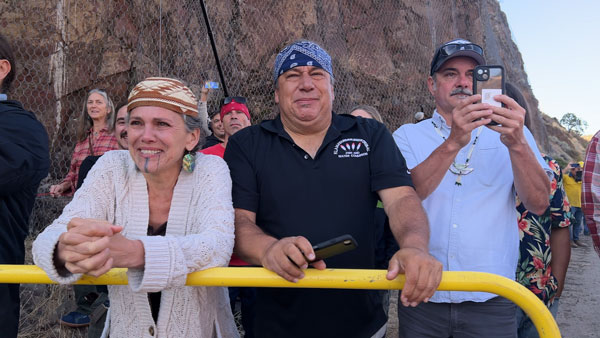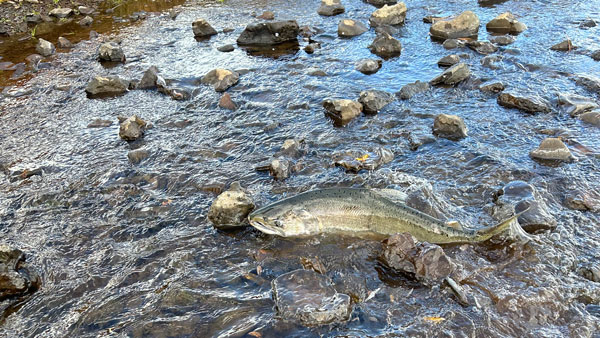Klamath Undammed
Salmon return, but years of work are ahead in America's largest river restoration
December 20, 2024
Dams have long been used to produce power and water for agriculture, but they can devastate river ecosystems. In a major victory for environmentalists and Native American communities, four aging hydroelectric dams on the Klamath River along the California/Oregon border were removed in 2024. It is the largest dam removal and river restoration project ever attempted in the U.S. opening up over 600 kilometers of habitat for migratory fish. Just two months after the final dam was breached, the first salmon found their way to a spawning site in the Klamath basin that had been out of reach for over a century.
Episode Five
Klamath River tribal members and environmentalists watch as the last dam is removed, freeing the river for the first time in over a century. Those gathered celebrate a victory decades in the making, while acknowledging that recovery of the river ecosystem will take many more years.
 Deconstruction of the Iron Gate Dam, part of the largest river restoration project in U.S. history. Hornbrook, California, August 28, 2024. / Credit: Matt Dibble, VOA News
Deconstruction of the Iron Gate Dam, part of the largest river restoration project in U.S. history. Hornbrook, California, August 28, 2024. / Credit: Matt Dibble, VOA News Karuk Tribal members and others watch as crews remove parts of the Iron Gate Dam freeing the Klamath River for the first time in over a century. August 28, 2024, Hornbrook, California. / Credit: Matt Dibble, VOA News
Karuk Tribal members and others watch as crews remove parts of the Iron Gate Dam freeing the Klamath River for the first time in over a century. August 28, 2024, Hornbrook, California. / Credit: Matt Dibble, VOA News
Episode Six
Two months after removal of the final dam, the first salmon have reached ancestral spawning grounds, having made a 370 kilometer journey up the river for the first time in over a century. But dam removal has come at a cost to some other species, which perished in sediment-clogged water and on treacherous mud flats. A herd of over two hundred wild horses plagues the re-vegetation efforts.
 A Chinook Salmon in a tributary of the Klamath River after removal of the dams, marking the first fish to return since 1916. October 16, 2024, Klamath Falls, Oregon / Credit: Mark Hereford, Oregon Department of Fish and Wildlife
A Chinook Salmon in a tributary of the Klamath River after removal of the dams, marking the first fish to return since 1916. October 16, 2024, Klamath Falls, Oregon / Credit: Mark Hereford, Oregon Department of Fish and Wildlife Wild horses at Klamath River restoration site. Hornbrook, California, August 27, 2024. / Credit: Matt Dibble, VOA News
Wild horses at Klamath River restoration site. Hornbrook, California, August 27, 2024. / Credit: Matt Dibble, VOA News
Episode Seven
The community of Copco Lake has lost the nearly 5 kilometer-long reservoir – a popular site for swimming, boating and fishing – that drew many residents to settle there. After reservoir draw-down the residents witnessed animals perishing on the exposed mudflats. Adjustment to the transformed landscape is challenging, but some are hopeful about a restored Klamath River.
 On dock at former Copco Lake, Hornbrook, California. / Credit: Chrissie Reynolds
On dock at former Copco Lake, Hornbrook, California. / Credit: Chrissie Reynolds Members of Hornbrook Fire Department attempt to rescue stranded deer at drained Copco Lake. January 27, 2024, Hornbrook, California. / Credit: Facebook/©Hornbrook Fire Protection District
Members of Hornbrook Fire Department attempt to rescue stranded deer at drained Copco Lake. January 27, 2024, Hornbrook, California. / Credit: Facebook/©Hornbrook Fire Protection District
Previous Episodes
Learn more about the Klamath dams and how environmentalists and tribes fought for their removal in episodes one through four.
Credits
- Reporter, Photographer and Video Editor
- Matt Dibble
- Animation and Graphics
- Mark Sandeen
- Web Design/Development
- Dino Beslagic, Stephen Mekosh
- Special Thanks
- Mia Bush, Scott Stearns, and the interview contributors who took time to share their stories with us
- Drone Footage
- Resource Environmental Solutions
